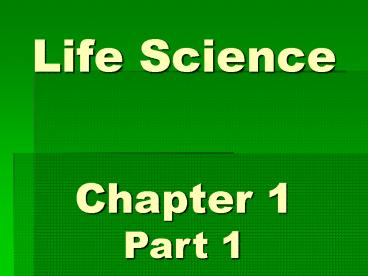Life Science - PowerPoint PPT Presentation
Title:
Life Science
Description:
Life Science Chapter 1 Part 1 The Cell Theory All living things are composed of cells. Cells are microscopic & are the basic unit of structure. Living cells come from ... – PowerPoint PPT presentation
Number of Views:53
Avg rating:3.0/5.0
Title: Life Science
1
Life Science
Chapter 1 Part 1
2
The Cell Theory
- All living things are composed of cells.
- Cells are microscopic are the basic unit of
structure. - Living cells come from other cells.
Most cells composed of structures called
organelles that have specific functions
3
Types of Microscopes
- Light Microscope
- Simple one magnifying lense
- Compound two or more magnifying lens
- Electron Microscope
- Uses a beam of electrons bounced off of the
specimen to form the image higher resolution of
image than light microscopes.
4
Parts of a Microscope
- Eye piece (ocular)
- Objective lens
- Stage
- Slide
- Coverslip
- Diaphragm
- Base
- Fine adjustment
- Coarse Adjustment
- Stage Clips
- Arm
How much magnification? Simply multiply the
magnification of the ocular lens (10x)
objective lenses (40x) 10 power x 40 power
400 power magnification
5
Robert Hookes Work
- English Scientist
- In 1663, he used a compound microscope
- Looked at tree bark cork
- Called the structures cells
Hookes actual drawing of cells
6
Leeuwenhoeks Work
- Dutch scientist
- In 1683, he used Simple microscope
- Looked at pond water
- He saw single celled animals swimming in the
water and called them animicules
7
Parts of a typical animal cell
- Cytoplasm jelly-like gooey material that holds
all of the cell structures - Cell Membrane Surrounding envelope , contains the
contents of the cell. - Semi permeable acts like a gate -allows only
certain things in out. - Biphospholipid layer
- Made of 2 layers of lipids (fats) w/ embedded
proteins. - Proteins float on lipids like marshmallow in a
cup of coco. - Hydrophobic hydrophilic ends of lipid molecule
8
Parts of a typical animal cell
- Nucleus
- the brain control center of the cell..
- 3 parts
- Chromatin material (chromosomes)
- Nuclear membrane w/ nuclear pores
- Nucleolus makes ribosomes
- Chromosomes are rod-like structures used to
direct the activity of the cells - Chromosomes are coiled up very long strands of
DNA
9
Parts of a typical animal cell
- Ribosomes (the tiny dots) made in the
nucleolus, move out into the rough ER and into
the cytoplasm. - ER - Endoplasmic Reticulum
- long tube-like highways that transport
materials throughout the cell - Two types
- Rough ER ER w/ ribosomes attached
- Smooth ER ER W/out ribosomes attached
10
Parts of a typical animal cell
- Mitochondria Powerhouse of the cell.
- Cristae the many folds inside the mitochondria
Surrounding envelope , contains the contents of
the cell. - Matrix space between the cristae
- ATP molecules (adenosine triphosphate) store high
amounts of energy that is released to the cell
when needed.
11
Parts of a typical animal cell
- Goli Body, Golgi Complex Golgi Apparatus all 3
are names for the same structure. - The Cellular Post Office
- packages, stores transports cellular materials
(proteins) to areas of the cell.
12
Parts of a typical animal cell
- Centrioles paired churro-like structures
found only in animal cells used in cell division
13
Parts of a typical animal cell
- Lysosome Spherical organelles that contain
digestive enzymes that breakdown broken or
damaged structures. The remaining pieces can be
reused by the cell. - Vacuoles
- Cellular containers
- 3 types include
- Food vacuoles
- Water vacuoles
- Waste vacuoles
14
Parts of a typical plant cell
- Plant cells have basically the same types of
organelles as animal cells EXCEPT for a few. - Plant cells have.
- Cell Wall surrounds the outside of the plants
cell membrane. - A. Usually composed of cellulose or chitin.
- B. Offers protection support
- Huge Gigundo Water Vacuoles aids in the
transport of water up the plant - Chloroplasts contain chlorophyll used to
convert suns energy into chemical energy via
photosynthesis - No Centrioles Plant cells have no centrioles
do not use them in cell division.
15
Quiz time fill-in the blanks
16
Quiz time fill-in the blanks































